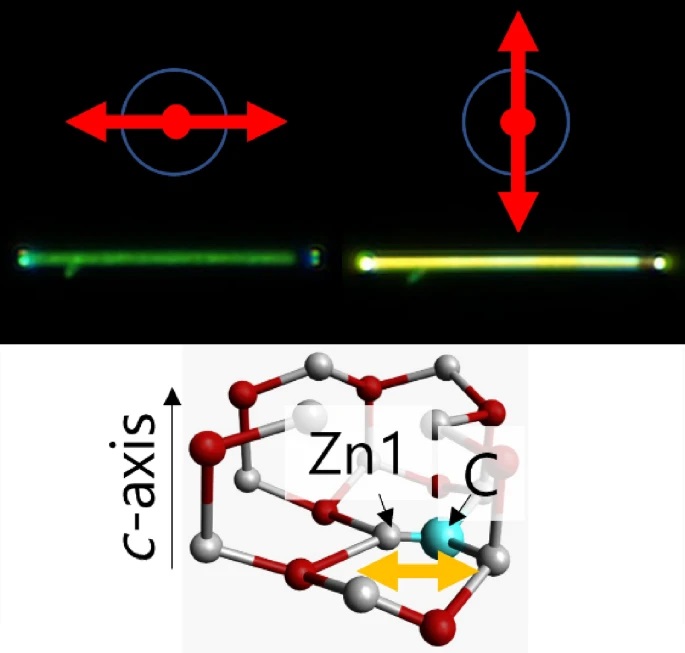 "Emission wavelength selection via anomalous polarized fluorescence in ZnO-C nanowires", Nano Research, 17, 4489
"Emission wavelength selection via anomalous polarized fluorescence in ZnO-C nanowires", Nano Research, 17, 4489
Defect fluorescence from high aspect ratio semiconductor nanowires typically displays a weak polarization parallel to the nanowire’s long axis due to dielectric mismatch in high aspect ratio media. Instead, anomalous 2.2 eV defect fluorescence distinctly polarized perpendicular to the nanowire is observed and measured from carbon-incorporated zinc oxide nanowires. These observations are significant because polarized defect emissions with consistent polarization on a mesoscopic scale are uncommon. Through a systematic study and comparison of experimental results with density functional theory calculations, an oriented defect complex comprising carbon substituting on an oxygen site and an oxygen vacancy (CO-VO) is deduced to be responsible for the anomalous yellow fluorescence, demonstrating a method for relating atomic-scale defect geometry to mesoscopic properties. The anomalous emission can appear in both green- and red-fluorescing nanowires grown with different carbon concentrations, verifying the independence and uniqueness of the 2.2 eV emission. This allows for polarization-dependent emission wavelength selection from a single nanowire.
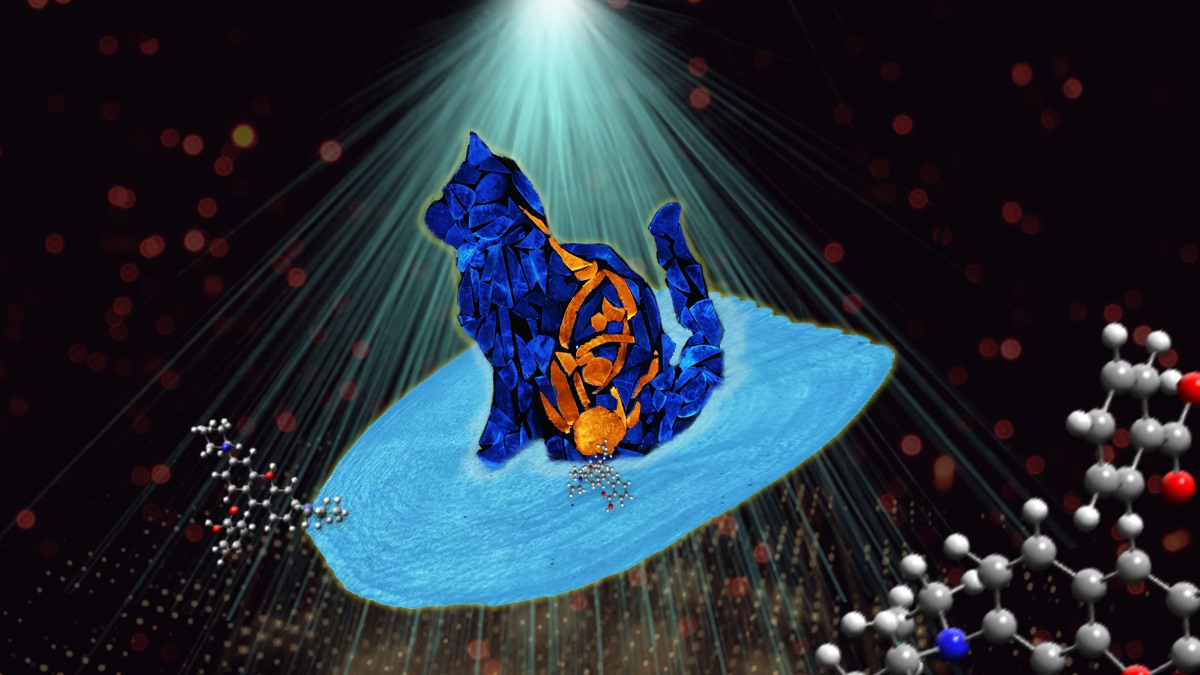 "Upcycling fish scales through heating for steganography and Rhodamine B adsorption application", Nature communications, 14, 6508
"Upcycling fish scales through heating for steganography and Rhodamine B adsorption application", Nature communications, 14, 6508
With increasing population and limited resources, a potential route for improving sustainability is increased reuse of waste materials. By re-looking at wastes, interesting properties and multifunctionalities can be discovered in materials previously explored. Despite years of research on bio-compatible fish scales, there is limited study on the fluorescence property of this abundant waste material. Controlled denaturation of collagen and introduction of defects can serve as a means to transform the fluorescence property of these fish scale wastes while providing more adsorption sites for pollutant removal, turning multifunctional fish scales into a natural steganographic material for transmitting text and images at both the macroscopic and microscopic levels and effectively removing Rhodamine B pollutants (91 % removal) within a short contact time (10 minutes). Our work offers a glimpse into the realm of engineering defects-induced fluorescence in natural material with potential as bio-compatible fluorescence probes while encouraging multidimensional applicability to be established in otherwise overlooked waste resources.
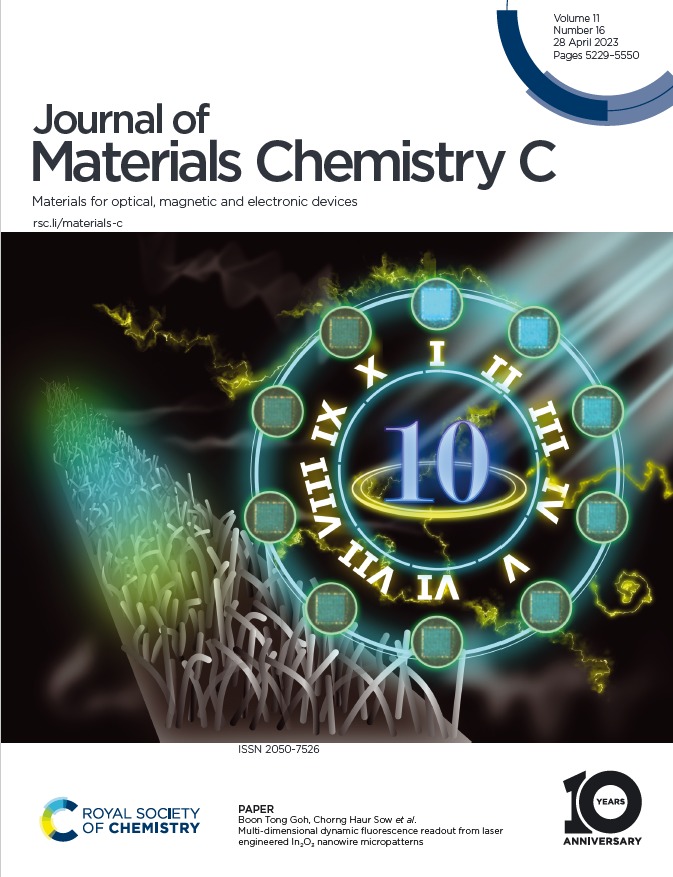 "Multi-dimensional dynamic fluorescence readout from laser engineered In2O3 nanowire micropatterns", J. Mater. Chem. C, 11, 5271
"Multi-dimensional dynamic fluorescence readout from laser engineered In2O3 nanowire micropatterns", J. Mater. Chem. C, 11, 5271
Laser-induced microscale reactions are an excellent means to obtain controllable, small-scale insights into nanomaterial properties. Importantly, the opportunity for a comprehensive understanding of the material's optical origins allows for refined engineering of material luminescence. Modifying an array of standing indium oxide (In2O3) nanowires with a focused laser beam, we report newfound yellow and blue fluorescence emanating from the sample. Evaluated through a broad range of laser conditions, the laser-induced yellow component was found to relate to oxygen inclusions, while the blue fluorescence overlayer originated from oxygen physisorption upon prolonged storage. Capitalizing on the versatility of the blue emission component under UV modulation, we demonstrate micropatterns with multiple layers of differentiated optical encryption features. The enhanced anti-counterfeiting capability allows improved complexity in an authentication process, involving the convergence of microscale patterning, dynamic color evolution and time-domain encoding as multilevel checkpoints in the verification process.
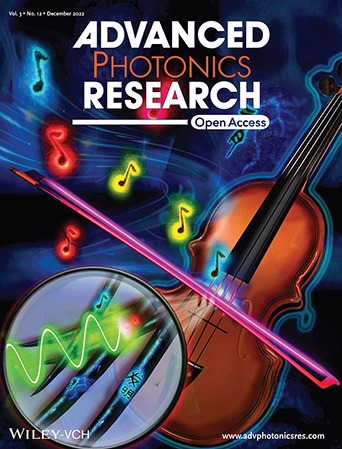 "Microstyling of Biofluorescence in Human Hair as Sustainable and Functional Waste", Advanced Photonics Research, 3, 2200161
"Microstyling of Biofluorescence in Human Hair as Sustainable and Functional Waste", Advanced Photonics Research, 3, 2200161
Human hair is a huge untapped waste resource whose useful compounds require toxic and environmentally harmful chemicals to extract. Herein, the optical properties of human hair without using such chemicals, turning waste into a site-selective multicolored display, and a chemical sensor with a visual indicator through tunable fluorescence are transformed. The tunable fluorescence color, which includes both visible light and infrared components, is achieved using a scanning laser beam (microscopic) and hotplate heating at a low temperature of 360 °C for 3 min (macroscopic and large-scale production). These fluorescing hair readily detects methylene blue molecules within a concentration range of 10-12–10-21 M due to the formation of tryptophan byproducts and electron contributing pyrrolic nitrogen. This work's simple yet impactful consequence lays the foundation on which the industrial applicability of the functionalized human hair waste can be achieved, realizing a possible cyclical economy through sustainable resources.
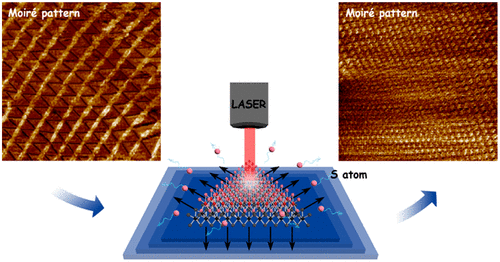 "Dynamic Tuning of Moiré Superlattice Morphology by Laser Modification", ACSNano, 16, 8172
"Dynamic Tuning of Moiré Superlattice Morphology by Laser Modification", ACSNano, 16, 8172
In artificial van der Waals (vdW) layered devices, twisting the stacking angle has emerged as an effective strategy to regulate the electronic phases and optical properties of these systems. Along with the twist registry, the lattice reconstruction arising from vdW interlayer interaction has also inspired significant research interests. The control of twist angles is significantly important because the moiré periodicity determines the electron propagation length on the lattice and the interlayer electron–electron interactions. However, the moiré periodicity is hard to be modified after the device has been fabricated. In this work, we have demonstrated that the moiré periodicity can be precisely modulated with a localized laser annealing technique. This is achieved with regulating the interlayer lattice mismatch by the mismatched lattice constant, which originates from the variable density of sulfur vacancy generated during laser modification. The existence of sulfur vacancy is further verified by excitonic emission energy and lifetime in photoluminescence measurements. Furthermore, we also discover that the mismatched lattice constant has the equivalent contribution as the twist angle for determining the lattice mismatch. Theoretical modeling elaborates the moiré–wavelength-dependent energy variations at the interface and mimics the evolution of moiré morphology.
 "Multifaceted Approaches to Engineer Fluorescence in Nanomaterials via a Focused Laser Beam", Light: Advanced Manufacturing, 3, 4
"Multifaceted Approaches to Engineer Fluorescence in Nanomaterials via a Focused Laser Beam", Light: Advanced Manufacturing, 3, 4
Fluorescent nanomaterials have long been recognized as essential contributors to the advancement of material technologies. Over the years, the rapid expansion in this massive selection of materials has led to the emergence of systems with tunable and unique fluorescent properties, occupying pivotal roles across niche areas in imaging, photonics, micro-encryption, and steganographic applications. In recent years, research interest in the translation of laser-based operations towards the production and modulation of nanomaterial fluorescence has been reignited, owing to its ease of operation and low cost. In this paper, we summarize the assortment of laser operations for the fabrication, modification, and spatial positioning of various fluorescent nanomaterials, ranging from metallic nanoparticles, carbon dots, 2D ultrathin films to wide-bandgap nanomaterials, and upconversion nanocrystals. In addition, we evaluate the importance of laser-modified fluorescence for various applications and offer our perspective on the role of laser-based techniques in the forthcoming advancement of nanomaterials.
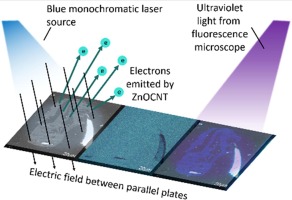 " Scintillating zinc oxide ensconced in a carbon nanotube forest engineered by laser micro-welding", Applied Surface Science, 562, 150231
" Scintillating zinc oxide ensconced in a carbon nanotube forest engineered by laser micro-welding", Applied Surface Science, 562, 150231
Herein, we report defect-introduction via focused-laser-beam (FLB) modification to introduce carbon defects into zinc oxide (ZnO) thin film. The approach begins with a carbon nanotube (CNT) array covered by a thin layer of sputtered Zn on top of the array. When FLB irradiates the covered CNT array under ambient conditions, effective laser energy absorption by CNT results in ZnOCNT nanohybrid formation, it also enables site-selective transformation to be achieved. By adjusting the laser power, the degree of carbon incorporation into the pristine Zn system can be tuned and this exerts some degree of control over the fluorescent properties of the nanohybrid. Generating a higher defect density increases the intensity and changes the wavelength of the fluorescence emitted by ZnO under ultraviolet (UV) excitation and enhances its field emission properties. In particular, the turn-on electric field (ETO) of the nanohybrid decreases. A lower ETO reduces the probability of arc formation, a significant problem currently undermining the industrial feasibility of field emission displays (FED). Electron emission from these samples can be enhanced by exciting the laser-treated sample with an external laser source. The normalised current produced increases by as much as 6µA/(mW/mm2) when the sample is excited by a 405 nm monochromatic laser.
Click here for past research highlights.
|


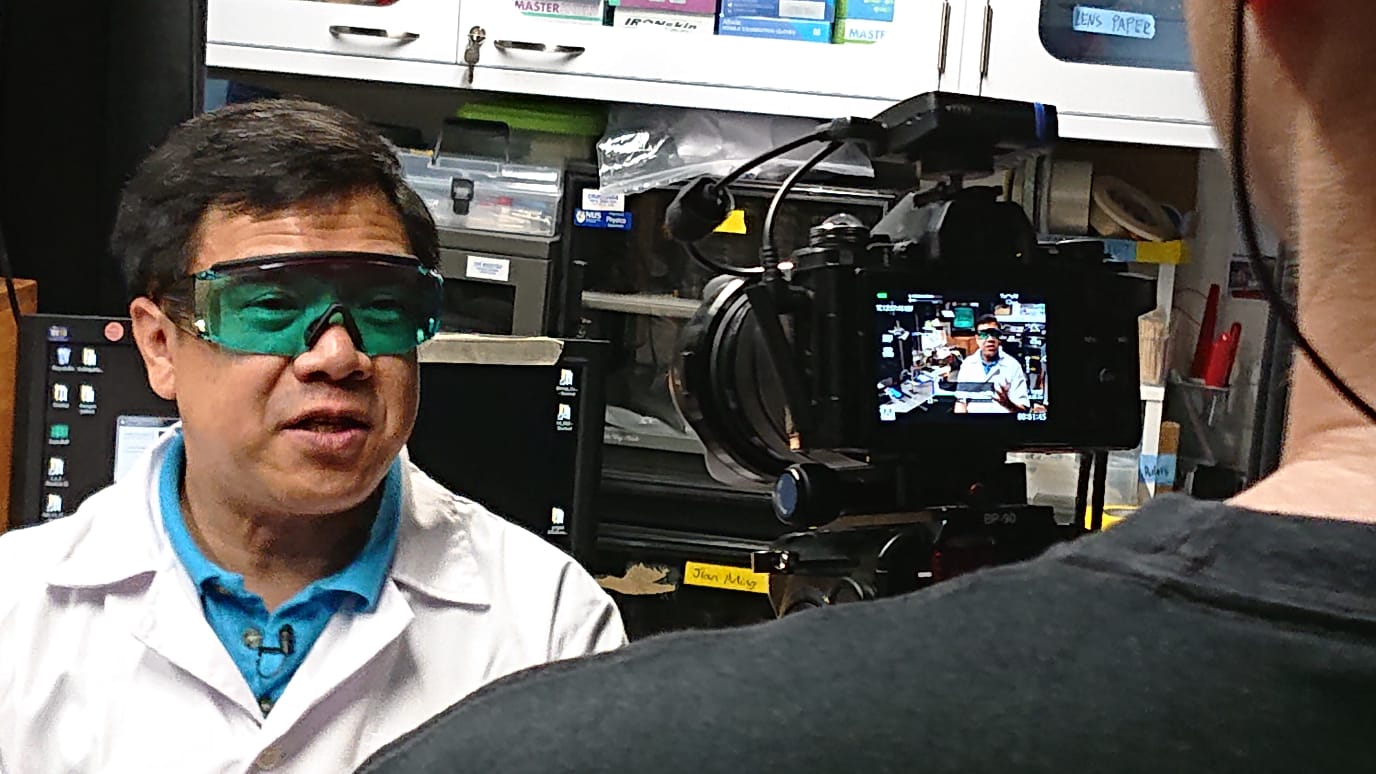

 "Emission wavelength selection via anomalous polarized fluorescence in ZnO-C nanowires", Nano Research, 17, 4489
"Emission wavelength selection via anomalous polarized fluorescence in ZnO-C nanowires", Nano Research, 17, 4489
 "Upcycling fish scales through heating for steganography and Rhodamine B adsorption application", Nature communications, 14, 6508
"Upcycling fish scales through heating for steganography and Rhodamine B adsorption application", Nature communications, 14, 6508
 "Multi-dimensional dynamic fluorescence readout from laser engineered In2O3 nanowire micropatterns", J. Mater. Chem. C, 11, 5271
"Multi-dimensional dynamic fluorescence readout from laser engineered In2O3 nanowire micropatterns", J. Mater. Chem. C, 11, 5271
 "Microstyling of Biofluorescence in Human Hair as Sustainable and Functional Waste", Advanced Photonics Research, 3, 2200161
"Microstyling of Biofluorescence in Human Hair as Sustainable and Functional Waste", Advanced Photonics Research, 3, 2200161
 "Dynamic Tuning of Moiré Superlattice Morphology by Laser Modification", ACSNano, 16, 8172
"Dynamic Tuning of Moiré Superlattice Morphology by Laser Modification", ACSNano, 16, 8172
 "Multifaceted Approaches to Engineer Fluorescence in Nanomaterials via a Focused Laser Beam", Light: Advanced Manufacturing, 3, 4
"Multifaceted Approaches to Engineer Fluorescence in Nanomaterials via a Focused Laser Beam", Light: Advanced Manufacturing, 3, 4
 " Scintillating zinc oxide ensconced in a carbon nanotube forest engineered by laser micro-welding", Applied Surface Science, 562, 150231
" Scintillating zinc oxide ensconced in a carbon nanotube forest engineered by laser micro-welding", Applied Surface Science, 562, 150231